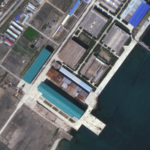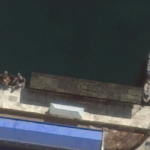April 20, 2021, by Joseph S. Bermudez Jr. and Victor Cha—
Satellite imagery on April 19 shows that North Korea has positioned a cylindrical object on the submersible missile test barge at Nampo.
This object could be a launch tube for an SLBM, but this cannot be confirmed yet based on available imagery... Satellite imagery on April 19 shows that North Korea has positioned a cylindrical object on…
April 14, 2021, by Joseph S. Bermudez Jr. and Victor Cha—
The recent repositioning of the submersible missile test stand barge and floating dry-dock were not isolated events, but components of a series of small naval movements at the shipyard during the past four weeks.
These activities have both practical and conspicuously political motivations as North Korea prepares to launch its new ballistic missile submarine (SSB) and Kim Jong-un apparently undertakes a policy of gradually increasing provocative military actions.
April 8, 2021, by Joseph S. Bermudez Jr. and Victor Cha—
The recent repositioning of the submersible missile test stand barge was not an isolated event, but the latest in a series of small naval movements at the shipyard during the past several weeks. Satellite imagery of the Sinpo South Shipyard and its environs acquired on April 6 and 7, 2021 shows not only the recent movement of the submersible missile test stand barge, but also provides a general status update of the facility.
April 6, 2021, by Joseph S. Bermudez Jr., Victor Cha and Jennifer Jun—
A Maxar Technologies satellite image collected at 11:09 AM KST on April 6 shows that North Korea is moving its submersible missile test barge located at the Sinpo South Shipyard. As no missile canister is visible onboard the submersible missile test barge, this movement does not indicate an imminent SLBM test.
March 19, 2021, by Joseph S. Bermudez Jr. and Victor Cha—
Minor activity is observed near the static test stand and the nearby Sinpo Shipyard’s graving dock in satellite imagery acquired on acquired on March 11, 2021. There are no indications of preparations of a forthcoming “pop-up” test of a submarine launched ballistic missiles (SLBM); however, the North could launch the new SSB or conduct additional SLBM tests at any time of its choosing.
February 10, 2021, by Joseph S. Bermudez Jr. and Victor Cha—
There are no visible indications of preparations for the launch of the much anticipated “newly built submarine”—North Korea’s first true ballistic missile submarine (SSB). No significant activity is observed in satellite imagery of the Sinpo South Shipyard collected during the past several months. Typical of this is an image acquired on February 3, 2021.
October 29, 2020, by Joseph S. Bermudez Jr. and Victor Cha—
Latest observations of the Sinpo South Shipyard show a return to its status quo of low-level activity. Notable vessels and objects have returned to, or remain at, their usual positions. A satellite image of the Sinpo South Shipyard acquired on October 27, 2020 shows a return to what has become typical activity within the facility’s secure boat basin.
October 5, 2020, by Joseph S. Bermudez Jr. and Victor Cha—
With the upcoming Korean Workers’ Party Foundation Day celebration on October 10, a SLBM test should not be ruled out as a possibility for Kim Jong-un’s self-proclaimed “October surprise.” Such a test would be consistent with Beyond Parallel historical data that shows heightened provocations around U.S. presidential election years.
September 9, 2020, by Joseph S. Bermudez Jr.—
An unidentified approximately 12-meter-by-1.75-meter yellow trailer or truck is on the same dock but immediately outside the secure boast basin. Speculation is that this may be a piece of construction equipment (e.g., a crane) or trailer transporting a missile container. We must reiterate that the resolution of the current image precludes positive identification so caution is urged.
September 8, 2020, by Joseph S. Bermudez Jr. and Dana Kim—
The Hungnam Fertilizer Complex has long been associated with producing chemical feed stocks or agents for North Korea’s nuclear weapons, chemical weapons and ballistic missile programs. Any modernization or improvement in its production capacities warrant close monitoring as they have the potential to support or augment WMD capabilities.










